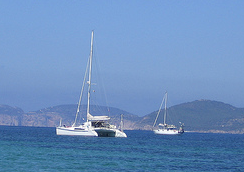Or search by topic
Number and algebra
Geometry and measure
Probability and statistics
Working mathematically
Advanced mathematics
For younger learners
Speeding Boats



Speeding Boats printable worksheet
Two boats travel up and down a lake, each at a constant speed. They turn at each end without slowing down. The boats start at opposite ends of the lake.

If the boats travel at the same speed, whereabouts on the lake will they meet for the first time? What about the second time they meet? Other meetings?
What would happen if one boat travelled twice as fast as the other?
Investigate where the boats will meet for other ratios of speeds.
Once you are confident at working with boats travelling at different speeds, why not try this challenge?
Can you work out the length of the lake and the ratio of the speed of the boats from the following information?
- The boats leave opposite ends A and B at the same instant
- They cross for the first time 600 metres from A
- After each boat has turned at the end of the lake, they cross for the second time 400 metres from B
Investigate the ratio of the speeds and the length of the lake when you change these distances. Can you find and prove a general result?
This problem is also available in French: Bateaux Sur Lac
You may also like
There and Back
Brian swims at twice the speed that a river is flowing, downstream from one moored boat to another and back again, taking 12 minutes altogether. How long would it have taken him in still water?
Escalator
At Holborn underground station there is a very long escalator. Two people are in a hurry and so climb the escalator as it is moving upwards, thus adding their speed to that of the moving steps. ... How many steps are there on the escalator?

